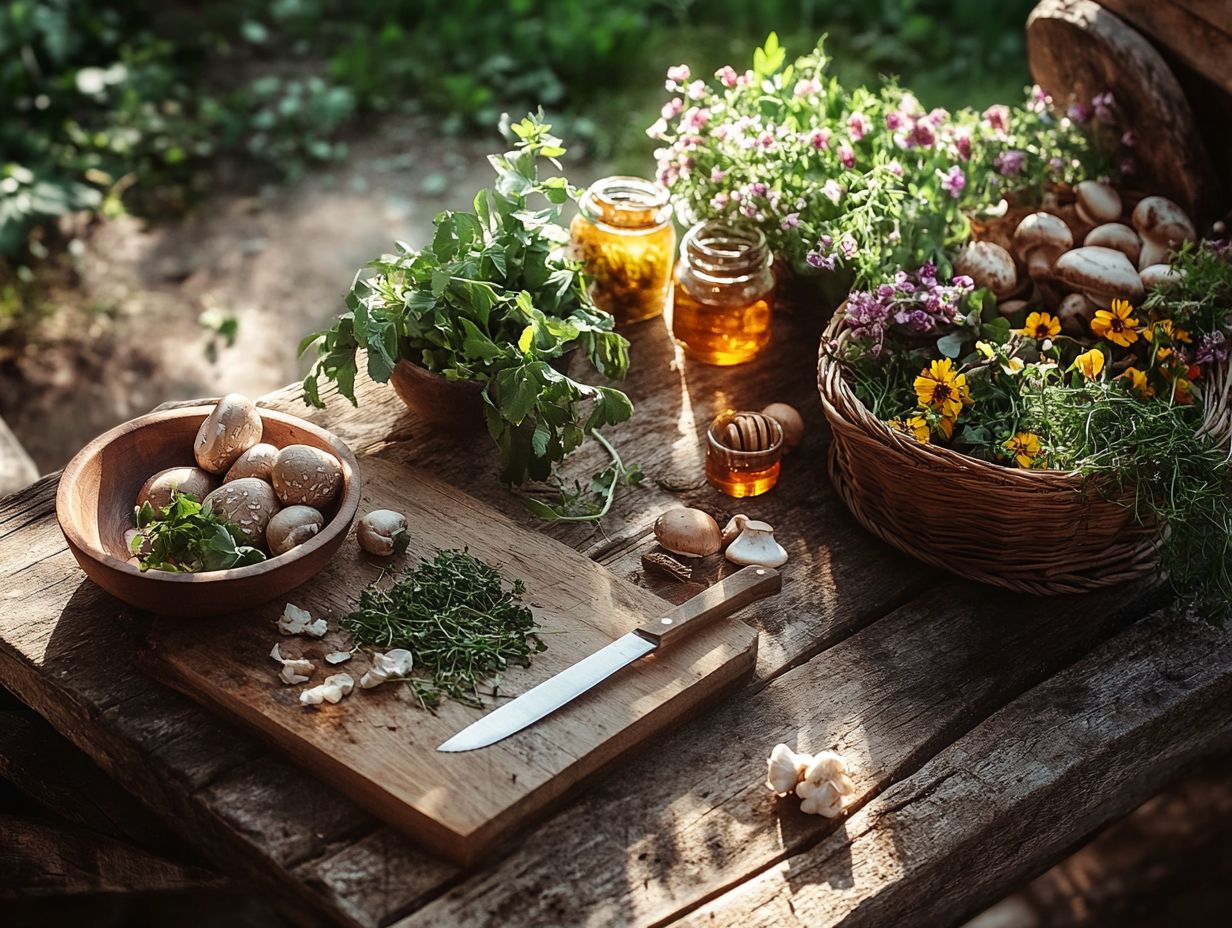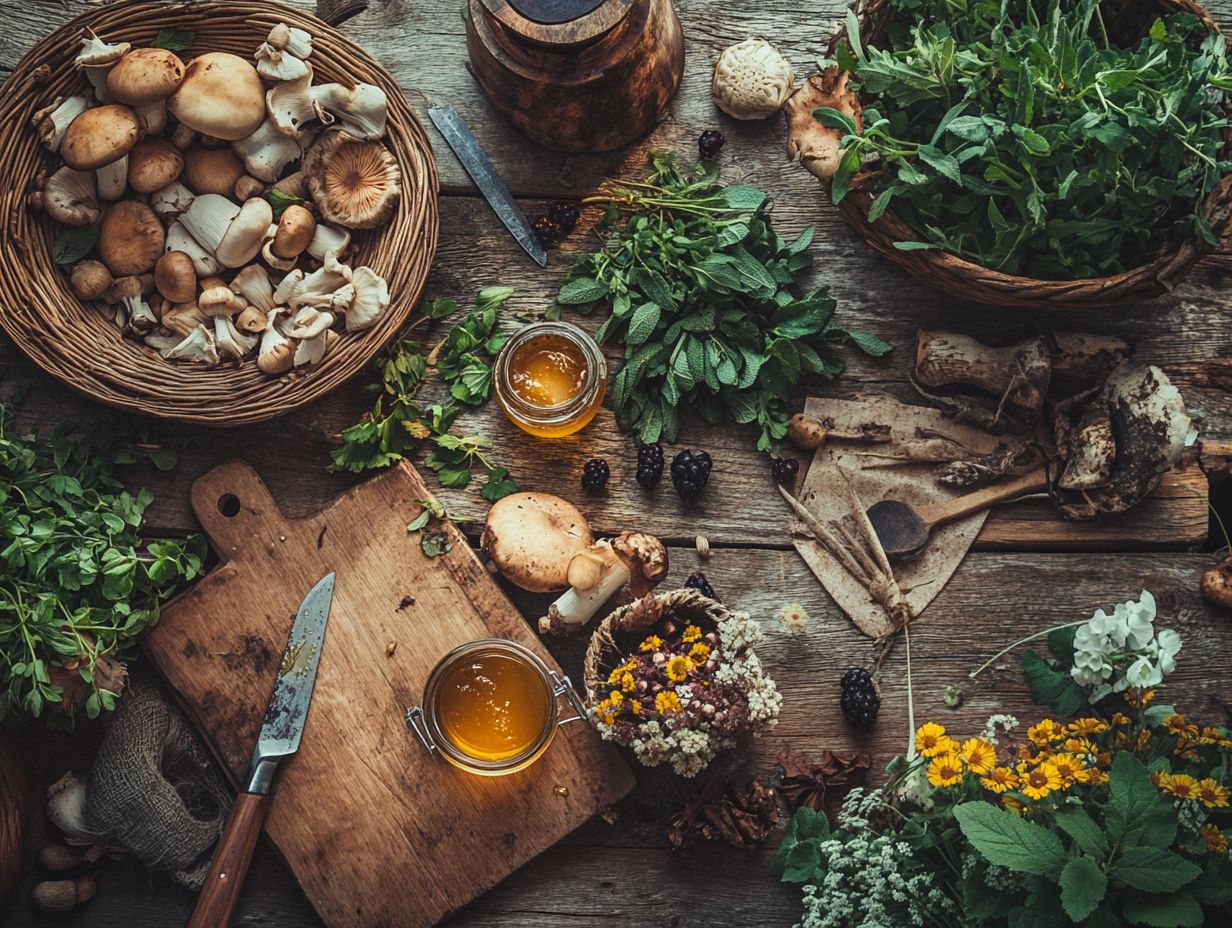How to Prepare Wild Edibles in Advance
Wild edibles present a remarkable opportunity to enrich your meals with unique flavors and nutrition. Yet many may overlook the advantages of preparing them ahead of time, especially given the diverse range of edible plants available for foraging.
This guide invites you to explore the fascinating world of wild edibles. It covers everything from plant identification and environmentally friendly foraging to harvesting, preservation, and ways to cook with them.
Uncover practical tips for safe foraging, including following safety guidelines and the universal edibility test. Explore innovative preservation techniques like drying and fermenting, and discover enticing recipes that showcase these natural ingredients.
Join the adventure of a lifetime and discover the incredible flavors nature has to offer!
Contents
- Key Takeaways:
- What are Wild Edibles?
- Benefits of Preparing Wild Edibles in Advance
- Identifying and Harvesting Wild Edibles
- Methods for Preserving Wild Edibles
- Recipes and Ideas for Using Preserved Wild Edibles
- Frequently Asked Questions
- What is the benefit of preparing wild edibles in advance?
- What are some common wild edibles that can be prepared in advance?
- How do I properly store prepared wild edibles?
- Can I freeze prepared wild edibles?
- How long can prepared wild edibles be stored?
- Are there any precautions to take when preparing wild edibles in advance?
Key Takeaways:

- Preparing wild edibles in advance offers convenience and nutrition, making it easier to incorporate them into your diet.
- Properly identifying and harvesting wild edibles with sustainable foraging practices is crucial for safety and preserving the environment.
- Preserving wild edibles through methods such as drying, freezing, and fermenting allows for their enjoyment and use in various recipes throughout the year.
What are Wild Edibles?
Wild edibles encompass a diverse array of plants and fungi that you can forage in nature. This includes common edible plants like dandelions and blackberries, which not only tantalize your taste buds but also come packed with health benefits.
Wild mushrooms like morels and chicken of the woods also offer unique flavors. Even the prickly pear cactus is ready to elevate your culinary creations. Foraging for these natural treasures provides a unique opportunity to connect with the environment while practicing sustainability.
However, mastering plant identification is essential. Knowing how to distinguish between edible delights and poisonous plants like death cap, monkshood, and oleander can ensure your foraging adventures remain both safe and enjoyable.
Benefits of Preparing Wild Edibles in Advance
Preparing wild edibles in advance offers a wealth of benefits, from enhanced convenience to improved nutritional value. Learning how to preserve edible plants after foraging makes incorporating wild food into your meals effortless.
By foraging sustainably, you can ensure a reliable supply of nutritious wild food, including edible weeds and wild herbs. This paves the way for creative cooking and adventurous flavor profiles in your everyday meals.
Understanding how to efficiently prepare and store these edible plants allows you to savor their health benefits even during off-seasons. You can keep your pantry stocked with nature s bounty, utilizing resources like Steve Brill’s field guide.
Convenience and Nutrition
Having wild edibles at your fingertips can elevate your meal preparation. You ll also receive optimal nutrition from sources like dandelions and blackberries.
Imagine harvesting edible plants from your local foraging adventures. These wild wonders offer essential vitamins and minerals and can be a powerful addition to your diet. By honing your foraging skills, you can enjoy a diverse array of nutritious options right in your backyard.
This not only nudges you toward healthier eating habits but also opens up a world of creative meal planning that highlights seasonal ingredients. Skills such as plant identification, proper harvesting techniques, and an understanding of local ecosystems can greatly enhance your foraging efficiency, turning casual outings into productive culinary escapades.
With an abundance of wild herbs, greens, and fruits at your disposal, meal prep transforms into a delightful adventure. This lessens your reliance on store-bought alternatives. Embracing these natural foods not only elevates your meals but also deepens your connection to nature, paving the way for a more sustainable lifestyle.
Identifying and Harvesting Wild Edibles

Identifying and harvesting wild edibles is a refined skill. It demands a deep understanding of plant identification, local ecosystems, and the dangers posed by toxic species, which are plants that can cause harm if eaten, such as horse nettle and poison ivy. Accurate identification is essential for a successful foraging experience, allowing you to confidently differentiate between tasty plants like prickly pear cactus and hazardous counterparts such as monkshood.
Honing your foraging skills lets you gather wild foods safely, enhancing your diet while upholding your commitment to safety.
Tips for Safe and Sustainable Foraging
To ensure safe and sustainable foraging, it’s vital for you to follow established safety guidelines, like the leave no trace principles, while refining your foraging skills. Familiarizing yourself with a method to see if a wild food is safe to eat can enable you to identify which wild foods are safe to consume. Practicing responsible foraging practices will ensure that you leave the environment undisturbed, promoting the continued growth of wild edible plants.
Before you consume any unfamiliar plant, this method is an excellent starting point. It involves identifying the plant and testing small amounts while carefully observing for any allergic reactions or negative side effects.
Embracing sustainable practices, such as only harvesting what you truly need, helps foster a healthy balance in nature. Understanding local biodiversity and respecting habitats contributes positively to the environment while you enjoy the many benefits that wild foraging offers.
Methods for Preserving Wild Edibles
Preserving wild edibles is exciting! It lets you enjoy their flavors all year long while maximizing their shelf life and retaining their nutritional value. You can employ various methods, such as drying, freezing, and fermenting, to ensure that your bounty of wild food think dandelions and morels can be savored throughout the year.
Each preservation technique brings its own unique flavors and textures, elevating your meals with the true essence of nature.
Drying, Freezing, and Fermenting
Drying intensifies flavors, freezing keeps fruits fresh, and fermenting adds probiotics. Each method has unique benefits for your wild food. Drying removes moisture through air or heat, making it perfect for herbs like thyme and oregano, which can be stored in airtight containers for months. Freezing helps maintain the vibrant color and texture of seasonal fruits and vegetables, such as peas and cherries, ensuring they retain their nutritional value. Fermentation is particularly fascinating; it not only extends shelf life but also enhances the nutritional profile of foods like wild cabbage or radishes, transforming them into tangy, probiotic-rich side dishes.
By grasping these methods, you enable yourself to make informed choices about your wild foraging and preservation endeavors.
Recipes and Ideas for Using Preserved Wild Edibles

Exploring recipes that incorporate preserved wild edibles unveils a realm of culinary creativity. Imagine dishes featuring preserved blackberries or flavorful wild cabbage, enabling you to savor the vibrant flavors of nature year-round. You can add dried dandelion leaves to your soups or use frozen blackberries to craft a delightful dessert. The versatility of preserved wild foods can truly elevate any dish.
These culinary inspirations will maximize your foraging adventures, ensuring that every wild edible is thoughtfully utilized and nothing goes to waste.
Creative and Delicious Ways to Enjoy Wild Edibles
Using edible flowers like nasturtium can change how you cook, introducing unique flavors that elevate your meals. Picture this: a vibrant salad featuring fresh nasturtium or a delightful pie crafted from preserved blackberries. You can create many delicious dishes by incorporating wild foods into your kitchen. By working with a variety of preserved wild edibles, you can develop innovative recipes that reflect the seasonal ingredients around you.
Incorporating wild ingredients, such as dandelion greens or elderflower, into your savory dishes can significantly enhance the flavors, providing a delightful contrast to traditional recipes. You can also enhance your dishes by pairing these edibles with complementary ingredients like creamy goat cheese or rich walnut oil which creates harmonious bites that dance on your palate.
Presentation is important; try this vibrant salad drizzled with elderflower vinaigrette, garnished with edible flowers like nasturtium. Wild mushrooms preserved in oil can be saut ed to perfection, turning a simple pasta dish into a beautiful dish. Each recipe you create not only becomes a culinary adventure but also showcases the beauty and potential of foods you gather from nature.
Frequently Asked Questions
What is the benefit of preparing wild edibles in advance?
Preparing wild edibles in advance keeps nutritious meals ready for you from your foraging adventures, especially if you know how to preserve wild edibles.
What are some common wild edibles that can be prepared in advance?

- Dandelion
- Blackberries
- Wild mushrooms
- Berries
- Greens
- Nuts
How do I properly store prepared wild edibles?
It is important to store prepared wild edibles in airtight containers in a cool, dark place to maintain freshness and prevent spoilage.
Can I freeze prepared wild edibles?
Yes, freezing is an excellent way to preserve prepared wild edibles for longer periods. Just be sure to label and date the containers for easy identification.
How long can prepared wild edibles be stored?
This depends on the type of wild edibles and how they were prepared. Generally, they can be stored for several months in proper conditions, but it is recommended to consume them within a few weeks for optimal freshness.
Are there any precautions to take when preparing wild edibles in advance?
It is important to properly identify and wash all wild edibles. Follow safety guidelines and use plant identification techniques before preparing them. Also, ensure you use proper food safety practices, such as washing hands and using clean utensils, to avoid contamination.
Get outside and discover the wild flavors that await you!






